Unleashing Hidden Potential: Upcycling Everyday Waste into Unique Decor
Transforming trash into treasure is more than just a trendy catchphrase--it's a creative revolution. Upcycling everyday waste into unique decor offers an eco-friendly approach to beautifying your home while reducing landfill waste. Dive into the world of innovative decor, where discarded items gain new purpose, and your living spaces radiate one-of-a-kind charm.
Why Upcycling Matters: A Green Shift in Home Decor
Upcycling has rapidly gained momentum as eco-conscious individuals and interior designers alike seek to unleash the potential of everyday waste. This sustainable solution diverts refuse from landfills, reduces the demand for new resources, and fosters creativity in home design. Let's explore why upcycling waste into home decor isn't just a trend--it's an essential movement towards a healthier planet and personalized lifestyle.
Benefits of Upcycling Waste into Decor
- Environmental Impact: Less landfill waste and lower carbon footprint.
- Unique Style: Each upcycled creation is inherently one-of-a-kind.
- Cost Savings: Repurposing materials saves you money on decor purchases.
- Personal Satisfaction: Crafting meaningful items adds emotional value to your home.
- Creative Expression: Upcycling nurtures your imagination and DIY skills.

Upcycling vs. Recycling: What's the Difference?
Many people use these terms interchangeably, but understanding the nuances can help you better evaluate your waste-reduction strategies:
- Recycling transforms waste materials into new, often lower-quality products by breaking them down and remanufacturing (e.g., melting glass or plastics).
- Upcycling repurposes waste without breaking it down, giving it a higher value than the original product--such as turning old jars into chic pendant lights or scrap wood into rustic shelves.
In short, upcycling boosts aesthetic and ecological value, while recycling typically focuses on resource recovery at a broader scale.
Everyday Items with Untapped Potential for Upcycling
Think about your daily discards--these seemingly insignificant items become raw materials in the right hands. Here are some common waste products ready for transformation:
- Glass jars and bottles
- Plastic containers and caps
- Wooden crates and pallets
- Old T-shirts and jeans
- Cardboard boxes
- Bottle corks
- Tin cans
- CDs and DVDs
- Broken furniture
- Used paper rolls
Every household has at least a handful of these items awaiting a second life--let's discover how to turn them into stunning decor.
Clever Upcycling Ideas: Turn Waste Into Wow!
1. Glass Jar Lanterns and Vases
- Clean any used glass jar thoroughly.
- Paint or decorate the exterior with glass-friendly markers, lace, or twine.
- Place a tea light candle or LED string inside for a cozy glow, or fill with fresh or dried flowers for a DIY vase.
Pro Tip: Combine jars of differing sizes on a tray for a picturesque centerpiece.
2. Pallet Wood Shelves and Tables
- Sand down old pallets and treat with eco-friendly varnish.
- Mount to walls as rustic shelving, or stack and secure for a coffee table.
- Decorate with plants, books, or upcycled jars for that extra flair.
3. Plastic Bottle Planters
- Cut plastic bottles in half and puncture drainage holes at the bottom.
- Paint exteriors with vibrant designs, or wrap in jute for a natural look.
- Plant succulents, herbs, or flowers and display on windowsills or patios.
Upcycling plastic not only reduces waste, but also adds greenery to your space!
4. Tin Can Pencil Holders and Wall Art
- Remove labels and sharp edges from tin cans.
- Decorate with decoupage, washi tape, or spray paint.
- Glue several together as a desk organizer or decorate individually as wall-mounted containers.
5. Upcycled Fabric Cushions and Rugs
- Cut old T-shirts or jeans into strips.
- Knit, braid, or weave the strips into colorful rugs or cushion covers.
- Embellish with leftover buttons, embroidery, or appliques for a personalized touch.
6. CD Mosaic Decor
- Break old CDs carefully into small pieces.
- Arrange and glue onto frames, flower pots, or trays for a shimmering mosaic effect.
This is a perfect way to unleash hidden potential from obsolete technology.
Getting Started: Tips for Effective Upcycling
- Clean and Prep: Wash items thoroughly; remove labels, adhesives, and residues.
- Safety First: Use gloves, eye protection, and ventilated areas when cutting, painting, or sanding.
- Use Quality Tools: Good scissors, paintbrushes, hot glue guns, and drills make all the difference.
- Plan Ahead: Sketch or visualize your project before cutting or assembling materials.
- Get Inspired: Scour platforms like Pinterest, YouTube, or Instagram for upcycling ideas and tutorials.
- Practice Patience: Some projects require trial and error to perfect.
From Waste to Wow: Showcasing Success Stories
Looking for proof that upcycled decor can transform spaces? Here are inspiring stories from real-life enthusiasts and artists:
Case Study 1: The Bottle Cap Mural
A community group in Austin, Texas collected thousands of discarded bottle caps and collaborated to create a massive mural for a local park. This vibrant artwork not only beautified the neighborhood but encouraged residents to think differently about their waste.
Case Study 2: Furniture from Forgotten Pallets
Interior designers across Europe are now upcycling shipping pallets into trendy furniture--think coffee tables, bed frames, and outdoor lounges. Every piece tells a story through its grain and imperfections, proving that upcycling can rival high-end decor.
Case Study 3: Repurposed Denim Wall Hangings
Fashion bloggers and sustainable artists alike love transforming old jeans into textured wall art. The deep blue hues and tactile surfaces add warmth and unique style to interiors, putting otherwise discarded fabric back in the design spotlight.
Making Upcycling Stylish: Trends and Techniques
Upcycling everyday waste into home decor is as much about aesthetic as about ethics. Here's how to ensure your creations are not only eco-friendly but also stylish and on-trend:
- Minimalism: Upcycle with simple lines--think monochrome painted bottles or geometric pallet shelves.
- Boho Chic: Utilize natural fibers, earthy tones, and eclectic patterns from upcycled textiles.
- Industrial Fusion: Mix metals, glass, and reclaimed wood for an urban vibe.
- Farmhouse Charm: Sanded pallets, mason jars, and upcycled wooden crates exude rustic elegance.
- Personalized Art: Turn keepsakes and mementos into wall displays or shadow boxes for added sentimentality.
Remember, the beauty of upcycled decor lies in its imperfections. Embrace the story behind each material--those nicks and scratches add character and authenticity.
Sustainability and the Circular Economy: The Bigger Picture
Upcycling isn't just about beautifying your space; it's a core component of the circular economy--a system focused on reusing and regenerating materials. Every upcycled decor item you create reduces demand for new products, preserves resources, and inspires others to rethink waste.
By transforming discarded items into functional, beautiful art, you actively participate in building a more sustainable, mindful world.
Quick Upcycling Projects for Beginners
- Wine Cork Pin Board: Glue wine corks in a frame to make a handy, rustic pin board.
- Egg Carton Wall Flowers: Paint individual cups and cluster together on the wall for playful blooms.
- Pringles Can Desk Organizer: Wrap empty cans with colorful paper or fabric to sort office supplies.
- Mason Jar Soap Dispenser: Fit a pump lid onto a jar, perfect for soap or lotion in the kitchen or bathroom.
- Plastic Spoon Mirror Frame: Adhere painted plastic spoons around a mirror for a dramatic, upcycled focal point.
Upcycling in the Community: Workshops and Resources
Many cities now offer upcycling workshops, recycling centers, and swap meets to help individuals ignite their creative spark using everyday waste. Seek out local makerspaces, environmental NGOs, or art collectives that host:
- Guided classes in upcycled decor techniques
- Material swaps to exchange reusable waste items
- Online resources and video tutorials
- Competitions or exhibitions to display your creations
Don't hesitate to connect with fellow upcyclers--sharing ideas and learning new skills can multiply your creativity and impact.

Frequently Asked Questions about Upcycling Decor from Waste
- Q: What's the best place to start if I'm new to upcycling?
A: Begin with small projects, such as glass jar vases or tin can organizers. Gather inspiration online and experiment with materials you already have at home. - Q: How do I make sure my upcycled decor is safe to use?
A: Always clean materials thoroughly and avoid toxic finishes. Watch for sharp edges or unstable structures, and use child-safe paints/glues where necessary. - Q: Can upcycled decor be as attractive as store-bought items?
A: Absolutely! In fact, the unique imperfections and stories behind each piece add immense character that mass-produced products can't replicate. - Q: Does upcycling save money?
A: Yes--using what you already have or picking up free materials drastically cuts down decor expenses, all while benefiting the environment.
Conclusion: Redefining Creative Living
Unleashing hidden potential in everyday waste is about reimagining what's possible. Upcycling is not just a design choice--it's a statement of resourcefulness and responsibility, turning the ordinary into the extraordinary.
With a bit of vision, some basic tools, and a willingness to experiment, you can turn your household castaways into beautiful, functional, and unique decor. So, unlock your creativity, support a greener world, and fill your home with pieces that carry both meaning and inspiration. The future of decor isn't in what you buy--it's in what you create.
Ready to unleash your creativity? Start upcycling today and let your home tell a story of transformation!
